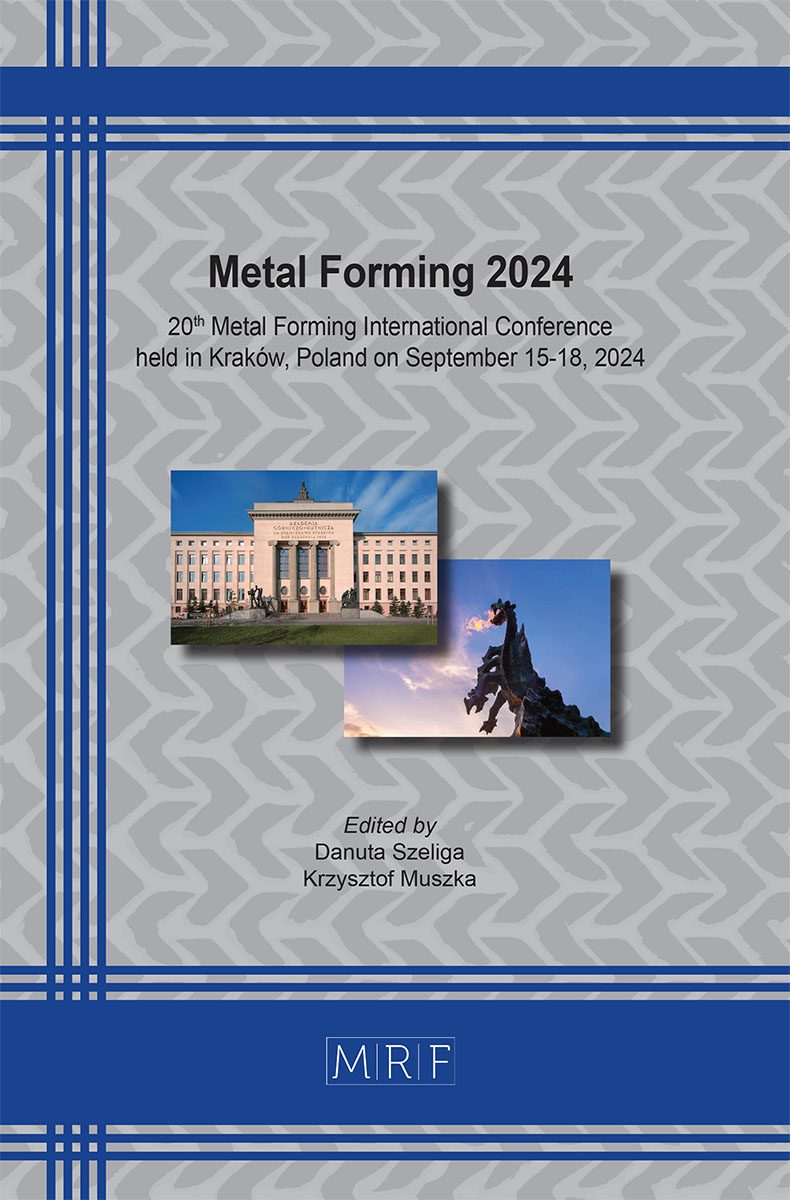–
The continuous rotary extrusion (CRE) process of the AZ31 magnesium alloy with various deformation zone geometry
MITKA Monika, MISIOLEK Wojciech Z., LECH-GREGA Marzena, LIMANÓWKA Kamila, SZYMAŃSKI Wojciech
download PDFAbstract. The presented studies are focused on the continuous rotary extrusion (CRE) process, also known in the literature under the Conform® name. The CRE process is commonly used for aluminum and copper alloys but is new for magnesium alloys. A broader understanding of the application of the CRE process and the input material, the AZ31 magnesium alloy, enables the combination of a new, economical method of plastic deformation of the material with the desired final properties. The main aim of the presented work was to analyze how different deformation zone geometry influences the quality of the extruded AZ31 magnesium rods. Additionally, the properties of the CRE extruded rods were compared to the traditionally directly extruded (DE) rods. The research was conducted to analyze the impact of the CRE process parameters on the mechanical properties of the obtained rods, as well as on changes occurring in grain size, texture, and the level of recrystallization.
Keywords
AZ31 Magnesium Alloy, CRE, Conform®, Δ Parameter, Mechanical Properties, EBSD
Published online 9/15/2024, 8 pages
Copyright © 2024 by the author(s)
Published under license by Materials Research Forum LLC., Millersville PA, USA
Citation: MITKA Monika, MISIOLEK Wojciech Z., LECH-GREGA Marzena, LIMANÓWKA Kamila, SZYMAŃSKI Wojciech, The continuous rotary extrusion (CRE) process of the AZ31 magnesium alloy with various deformation zone geometry, Materials Research Proceedings, Vol. 44, pp 736-743, 2024
DOI: https://doi.org/10.21741/9781644903254-78
The article was published as article 78 of the book Metal Forming 2024
![]() Content from this work may be used under the terms of the Creative Commons Attribution 3.0 license. Any further distribution of this work must maintain attribution to the author(s) and the title of the work, journal citation and DOI.
Content from this work may be used under the terms of the Creative Commons Attribution 3.0 license. Any further distribution of this work must maintain attribution to the author(s) and the title of the work, journal citation and DOI.
References
[1] E. Friedrich, B. L. Mordike, Magnesium Technology. Metallurgy, Design Data, Applications. Springer Science & Business Media, Berlin Heidelberg, 2006.
[2] E. Hadasik, D. Kuc, Obróbka plastyczna stopów magnezu, Obróbka plastyczna metali 24 (2013) 131-146.
[3] M. Mitka, M. Gawlik, M. Bigaj, W. Szymański, The Effect of Extrusion Parameters on Possibility of Extrusion of Magnesium Alloys in Continuous Rotary Extrusion Process, Arch. Metall. Mater. 60 (2015) 2981-2984. https://doi.org/10.1515/amm-2015-0476
[4] J. Zasadziński, T. Knych, E. Dziedzic, Badanie procesu wyciskania metodą Conform w produkcji wyrobów i recyklingu aluminium i jego stopów, Rudy i Metale Nieżelazne R-52 (2007) 757-767.
[5] Y. Kim, J. Cho, H. Jeong, K. Kim, S. Yoon, A study on optimal design for CONFORM process, J. Mater. Process. Tech. 80-81 (1998) 671-675. https://doi.org/10.1016/S0924-0136(98)00173-3
[6] M. Mitka, M. Gawlik, M. Bigaj, W. Szymański, W.Z. Misiołek, Continuous rotary extrusion of AZ81 magnesium alloy, Procedia Manuf. 15 (2018) 257-263. https://doi.org/10.1016/j.promfg.2018.07.217
[7] W.F. Hosford, R.M. Caddell, Metal Forming. Mechanics and Metallurgy, Cambridge University Press, 2011.
[8] M. Nienaber, G. Kurz, D. Letzig, K.U. Kainer, J. Bohlen, Effect of Process Temperature on the Texture Evolution and Mechanical Properties of Rolled and Extruded AZ31 Flat Products, Crystals 12 (2022) 1307. https://doi.org/10.3390/cryst12091307












